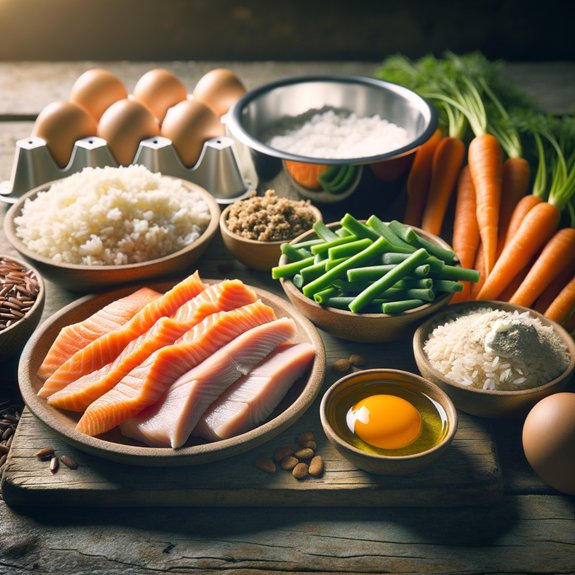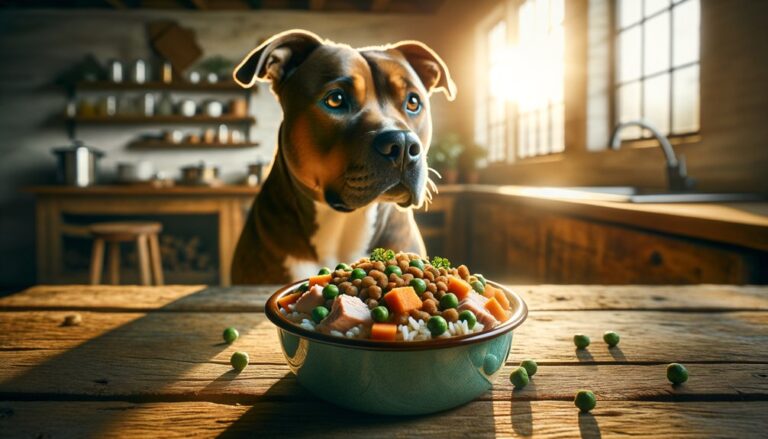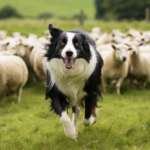The Best Fluffy Pancakes recipe you will fall in love with. Full of tips and tricks to help you make the best pancakes.

Curious which homemade dog diets truly meet canine nutritional needs—learn balanced recipes, safe swaps, and common pitfalls to avoid before you start feeding. Think of a homemade dog diet as a carefully tuned engine you help maintain for peak performance; you’ll want parts that fit and work reliably. You’ll need clear rules on proteins, carbs, fats, and micronutrients so meals meet needs without gaps. I’ll give practical, evidence‑based guidance on safe ingredients, portioning, and simple templates you can rotate weekly — plus what to avoid and when to check with your vet.
Key Takeaways
- Build recipes around a core protein (40–50% calories), a digestible carbohydrate (20–30%), and vegetables (20–30%).
- Rotate three proteins and two carbohydrates weekly to ensure amino acid variety and reduce sensitivity risk.
- Include a calcium source and fish oil daily, and target about 10–15% of calories from fat adjusted for activity.
- Avoid toxic foods, raw diets without guidance, excess supplements, and improper Ca:P ratios; cook proteins safely.
- Work with a veterinary nutritionist and monitor weight, stool quality, and bloodwork every 3–6 months.

Essential Nutritional Principles for Homemade Dog Meals
Why does balance matter so much when you make your dog’s meals at home? You need to meet macronutrient and micronutrient targets reliably; imbalanced homemade diets can cause deficiencies or excesses that show up slowly but harmfully. Use evidence-based ratios for protein, fat, and carbohydrates tailored to life stage, and include calcium, phosphorus, vitamins A, D, E, B-complex, and trace minerals. You can work with a veterinary nutritionist or follow peer-reviewed formulation guides to ensure completeness. Monitor body condition, stool quality, energy, and integrate observations with routine veterinary testing. Share practical meal-planning templates with others in your community so everyone benefits from vetted guidance. Remember factors like age, activity, and health conditions when adjusting portions. While discussing feeding, keep broader two word discussion ideas in mind—puppy behavior and grooming routines—to support overall welfare. When in doubt, consult professionals rather than guessing; precision protects your dog’s long-term health and strengthens your role as a responsible caregiver.
Best Protein Sources and How to Prepare Them Safely
Which protein sources give your dog the best nutrition and how should you prepare them to minimize risk?
Lean meats (chicken, turkey, beef), fish (salmon, sardines), and eggs provide bioavailable amino acids dogs need. You should prioritize protein safety: buy fresh, inspect for odor or discoloration, and store promptly. Cook meats to at least 165°F for poultry and 145°F for whole cuts to kill pathogens; flake cooked fish and remove bones. Use pasteurized eggs or fully cook them to avoid Salmonella. Limit organ meats to small proportions for vitamins but don’t make them the sole protein. Preparation methods matter: gentle boiling, baking, or poaching preserve nutrients while ensuring safety; avoid added salts, onions, garlic, and seasonings toxic to dogs. If you consider raw feeding, consult a veterinarian and follow strict hygiene, sourcing, and freezing protocols to reduce bacterial risk. Keep portions balanced with guidance from your vet to fit your dog’s life stage and health.
Healthy Carbohydrates and Fiber Options for Dogs
You should balance proteins with digestible whole grains like brown rice, oats, and quinoa, which provide steady energy and micronutrients when cooked and served in appropriate portions.
Include fiber-rich vegetables such as steamed pumpkin, green beans, and carrots to support gut motility and stool quality, introducing them gradually to monitor tolerance.
Always check portion sizes and consult your veterinarian to match carbohydrate and fiber amounts to your dog’s age, size, and health needs.
Whole-Grain Choices
Curious which whole grains make the best carbohydrate and fiber sources for your dog? You’ll find oats, brown rice, quinoa, and barley offer reliable whole grain benefits: steady energy, soluble and insoluble fiber, and essential nutrients like B vitamins and minerals. Choose cooked, plain grains and introduce them gradually to monitor tolerance. If your dog has known allergies or pancreatitis, consult your vet before adding grains. Don’t buy grain free myths that imply grains are universally harmful; evidence shows many dogs digest whole grains well and they support gut health when balanced with protein and fat. You’re part of a community that values thoughtful, evidence-based nutrition—use measured portions and adjust recipes to your dog’s needs.
Fiber-Rich Vegetables
Want to boost your dog’s digestive health with whole-food ingredients? You can add fiber rich, vegetable based options that support regularity and gut microbes. Choose cooked pumpkin, steamed green beans, boiled sweet potato, or mashed peas in measured amounts—each supplies soluble and insoluble fiber without excess calories. Feed small portions, track stool quality, and adjust if your dog has sensitivities. Consult your veterinarian to balance calories, protein, and micronutrients.
| Vegetable | Benefit |
|---|---|
| Pumpkin | Soluble fiber, firms stool |
| Green beans | Low-calorie bulk fiber |
| Sweet potato | Resistant starch, vitamins |
| Peas | Fiber plus plant protein |

These fiber rich, vegetable based choices help you nourish your dog practically and safely while feeling part of a caring community.
Fats, Oils, and Omega Fatty Acids: Balancing Energy and Skin Health
You need to include essential dietary fats in recipes because they supply concentrated energy and support absorption of fat-soluble vitamins.
Prioritize omega-3 sources (like fish oil or flaxseed) for anti-inflammatory and skin benefits, while keeping omega-6 intake (from poultry and vegetable oils) balanced to avoid promoting inflammation.
Aim for a practical omega-6:omega-3 ratio—often around 5:1 to 10:1 depending on health goals—and adjust based on your dog’s condition and veterinary advice.
Essential Dietary Fats
How much fat should your dog get each day, and which types matter most? You’ll aim for roughly 10–15% of calories from fat for most adult dogs, adjusted for activity and body condition. Essential fats and fatty acids support energy density, nutrient absorption, and healthy skin and coat.
Include measurable sources: animal fats for calories, and small, consistent additions of approved oils for essential fatty acids.
Weigh ingredients, calculate calories, and consult guidelines or a veterinary nutritionist to ensure balances and avoid excess. Watch weight trends and skin condition as practical feedback.
Store oils properly to prevent rancidity. roviding balanced homemade meals your dog will thrive on.
Omega-3 Vs Omega-6
Curious which fats matter most for your dog’s skin, coat, inflammation, and overall health? You’ll want to balance omega 3 omega 6 as essential fats: omega-3s (EPA/DHA) reduce inflammation and support skin, omega-6s (linoleic acid) support barrier function and energy. Too much omega-6 relative to omega-3 can promote inflammation; too little limits skin repair. Aim for a practical target and consult your vet for ratios.
- Add a fish oil supplement standardized for EPA/DHA for anti-inflammatory support.
- Use modest amounts of plant oils (e.g., sunflower) to supply omega-6 without excess.
- Monitor coat, itchiness, and stool; adjust based on clinical response and veterinary testing.

You’re not alone—this is manageable with clear steps.
Vitamins and Minerals: Whole Foods and Appropriate Supplements
Which nutrients does your dog really need and where should they come from? You’ll focus on key vitamins minerals that support bone, immune, skin, and metabolic health. Prioritize whole foods: lean meats for B vitamins and iron, eggs for vitamin A and biotin, leafy greens and pumpkin for folate and beta‑carotene, and small amounts of dairy or fish for calcium and vitamin D. Whole foods supply cofactors that aid absorption and reduce imbalance risk.
You’ll also use targeted supplements when bloodwork or a veterinary nutritionist indicates gaps. Choose labeled pet products with controlled dosages—vitamin D, calcium, iodine, or omega‑3s—rather than human multivitamins. Avoid routine high‑dose fat‑soluble vitamins unless prescribed. Track portions, rotate ingredients, and recheck labs every 3–6 months to confirm adequacy. When you collaborate with your vet, you join a community aiming for safe, evidence‑based homemade feeding that meets your dog’s lifelong needs.
Recipe Templates for Balanced Daily and Weekly Meals
Want a reliable framework for feeding that meets daily nutrient needs without guesswork? You’ll use repeatable templates that balance protein, fat, carbohydrates, fiber, and essential micronutrients across days. Build meals around a core protein source, a digestible carbohydrate, and a vegetable or fruit for fiber; add vet-approved supplements as needed. Rotate proteins weekly to cover amino acid variety and reduce sensitivity risk. Use portion calculators to match caloric needs
- Daily template: protein (40–50%), carbs (20–30%), vegetables (20–30%), plus fish oil and calcium source.
- Weekly rotation: three proteins, two carbohydrate types, one higher-fat day for active dogs.
- Record keeping: note weight, stool quality, and any two word discussion ideas to bring to your veterinarian; avoid unrelated topics during reviews.
These templates let you belong to a community of caregivers who feed intentionally, test results, and adjust based on objective measures.
Common Ingredients and Practices to Avoid
- Chocolate → causes → acute toxicity Source: American Veterinary Medical Association (AVMA)
- Grapes/raisins → cause → hemolysis Source: AVMA
- Onions/garlic/xylitol/alcohol → cause → hypoglycemia Source: AVMA
- Raw diets → risk → Salmonella/E. coli pathogens Source: American College of Veterinary Nutrition (ACVN)
- Raw diets → risk → nutrient imbalance Source: ACVN
- Excess calcium supplements → disrupt → calcium-to-phosphorus ratio Source: Journal of Veterinary Internal Medicine
- Excess calcium supplements → lead to → micronutrient excess Source: Journal of Veterinary Internal Medicine
- Extreme feeding practices → linked to → pancreatitis/hypertension/obesity Source: World Small Animal Veterinary Association (WSAVA)
- Safe food handling → requires → portion monitoring/freshness/storage Source: U.S. Food and Drug Administration (FDA)
- Safe food handling → requires → refrigeration/cooking at safe temperatures Source: FDA
- Veterinary nutritionist → ensures → balanced nutrition via blood monitoring Source: European Society of Veterinary and Comparative Nutrition (ESVCN)
Frequently Asked Questions
Batch reheating → requires → thawing in refrigerator + heating to 165°F (74°C) Source: FDA
Homemade diets → help → dog anxiety/behavior Source: Frontiers in Veterinary Science
Diet transition → requires → gradual incorporation (7–10 days) Source: AVMA
Raw diets for puppies → risk → pathogens/nutrient imbalance Source: FDA
Homemade meals for multiple dogs → require → vet‑formulated recipes/portion adjustments Source: WSAVA
Batch storage → requires → chilling/freezing/labeling
Conclusion
You’ll think homemade meals are just fancy leftovers, but they actually demand the same precision as a lab—because your dog’s health isn’t a guessing game. Use lean proteins, digestible carbs, fiber-rich veg, a calcium source, and a daily dose of fish oil; cook poultry safely and skip onions and garlic. Rotate proteins weekly, monitor portions with your vet, and confirm balance with routine blood work—yes, even homemade needs evidence.









